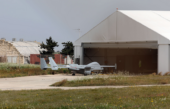The European Union is setting up a “Standing Corps” of 10,000 border guards, most of whom will be provided by the German Federal Police. The new President of the Commission wants the unit to be complete by 2024. Frontex will also be given more powers and change its organisational structure.
With a “Standing Corps” of 10,000 deployed personnel, the EU border agency Frontex enhance the shielding of the European Union. This is what the EU Commission’s proposal of 12 September 2018 to amend the Regulation on the European Border and Coast Guard (EBCG) states. The new border troops are to prevent crossings at Europe’s external borders and carry out returns and deportations.
Frontex currently has only civilian personnel and “borrows” forces for Joint Operations from the Member States. Until now, each mission has been the responsibility of a Member State of deployment. The Border Agency will be able to manage these operations itself under the new Regulation.
1,277 German police officers
The new “Standing Corps” will be established gradually. From 1 January 2021 onwards, 6,500 civil servants will be recruited, and by 2024 the figure will have risen to 8,000 according to current plans. Most of the personnel will be assigned as short-term deployments (a total of 5,500 police officers), while a further 1,500 will be long-duration secondments and another 1.500 as a “Reserve for Rapid Reaction”. Frontex will receive 3,000 civil servants as its own status personnel.
Approximately 10 percent of all the border agency’s forces are already provided by the German Federal Police, a total 1,277 German police officers are to be recruited as part of the “Standing Corps”. Frontex operations are also supported by the Federal Criminal Police Office and the Customs Administration.
The old European Parliament has already approved the growth of Frontex in principle; after a linguistic correction the Council and the new Parliament formally adopt the legal act according to “Rule 241” in the next weeks. Following its publication in the Official Journal of the European Union, the Regulation will probably enter into force at the end of the year. Ursula von der Leyen, the new President of the Commission, has announced that she will complete the establishment of the “Standing Corps” as early as 2024. However, it is unclear whether the Member States will be able to mobilise suitable personnel for this purpose. The discussion is therefore about increasing the salaries of civil servants as an incentive.
More surveillance of the “pre-frontier” area
Frontex has also enhanced its surveillance capabilities. The Border Agency operates the EUROSUR surveillance system, which monitors, inter alia, the coastal regions of Algeria, Tunisia and Libya. To this end, Frontex is testing the use of drones originally developed for the military. Research into the “pre-frontier” area off the coast of North Africa is now being extended to new regions.
For two years now, the Frontex border agency has been offering the possibility of monitoring their external borders from the air. Italy was the first Member State to order flights of this “Multipurpose Aerial Surveillance” (MAS) from 2017. A year ago, Frontex expanded its air surveillance service to include the countries of the Western Balkans, the Aegean Sea, the Black Sea and the Atlantic Ocean. Most flights are performed with manned systems, only in Portugal does Frontex carry out the MAS with a drone. For the first time, land borders were monitored with Croatia.
Operations in third countries
Because of the non-refoulement principle under international law, Frontex is not allowed to reject refugees at an external EU border. In the area of border surveillance, the new “Standing Corps” is therefore intended for use in third countries. The new Frontex Regulation facilitates such operations outside the EU. However, the EU Parliament did not want to agree to the execution of repatriations and deportations by Frontex there.
The Border Agency concluded a first operational agreement with a third country with Albania, the deployment began in May of this year. Further agreements with the governments in Bosnia, Serbia, Macedonia and Montenegro have already been negotiated, but still have to go through the legislative process there.
With the upgrading of Frontex, the Agency is planning a new organisational structure. The headquarters in Warsaw will remain responsible for monitoring and analysing migration and planning operations. Frontex will set up “antenna offices” in the operational EU Member States. Frontex Director Fabrice Leggeri will in future have three Executive Directors, their areas of responsibility still to be defined. The German Government reports on plans to “provide the Commissioner for Fundamental Rights with an additional deputy”.
Image: Joint operation “Poseidon” in Greece (all rights reserved Frontex).




